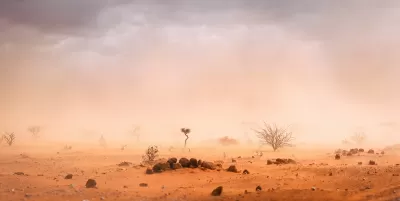The latest installment in the Mad Max franchise is a more urgent warning about the perils of climate change and megalomania than ever before.

In a piece on Common Edge, Josh Stephens writes, “It goes without saying that speculative fiction, no matter how outlandish, is meant to reflect the present at the same time that it anticipates the future, or at least a future. Director George Miller has imagined and reimagined ecological devastation and a resource-constrained hellscape ever since the original Mad Max, starring Mel Gibson, premiered in 1979. Forty-five years later, he returns to the same desert, dry and brutal as ever, with Furiosa: A Mad Max Saga.”
“No one is pushing us toward it more gleefully than our greatest industrialist-adolescent and would-be warlord: Elon Musk.”
“Musk’s juvenilia could be disregarded were it not accompanied by his inconceivable wealth and an almost orgasmic fatalism. Musk talks big game about his electric cars, battery packs, and renewable rockets. But he shows his true self in chilling ways: his assault on the marketplace of ideas; his sociopathic hatred of cities and, particularly, public transit; and, most of all, his fantasies of Martian colonization.”
“Oil, guns, megalomania, and trucks already have ruined much of our world. But, they haven’t ruined everything yet. The more furious the rest of us become, the better chance we have of winning the war.”
FULL STORY: Warlords in Our Midst

Trump Administration Could Effectively End Housing Voucher Program
Federal officials are eyeing major cuts to the Section 8 program that helps millions of low-income households pay rent.

Planetizen Federal Action Tracker
A weekly monitor of how Trump’s orders and actions are impacting planners and planning in America.

Ken Jennings Launches Transit Web Series
The Jeopardy champ wants you to ride public transit.

Washington Legislature Passes Rent Increase Cap
A bill that caps rent increases at 7 percent plus inflation is headed to the governor’s desk.

From Planning to Action: How LA County Is Rethinking Climate Resilience
Chief Sustainability Officer Rita Kampalath outlines the County’s shift from planning to implementation in its climate resilience efforts, emphasizing cross-departmental coordination, updated recovery strategies, and the need for flexible funding.

New Mexico Aging Department Commits to Helping Seniors Age ‘In Place’ and ‘Autonomously’ in New Draft Plan
As New Mexico’s population of seniors continues to grow, the state’s aging department is proposing expanded initiatives to help seniors maintain their autonomy while also supporting family caregivers.
Urban Design for Planners 1: Software Tools
This six-course series explores essential urban design concepts using open source software and equips planners with the tools they need to participate fully in the urban design process.
Planning for Universal Design
Learn the tools for implementing Universal Design in planning regulations.
Heyer Gruel & Associates PA
Ada County Highway District
Institute for Housing and Urban Development Studies (IHS)
City of Grandview
Harvard GSD Executive Education
Toledo-Lucas County Plan Commissions
Salt Lake City
NYU Wagner Graduate School of Public Service





























